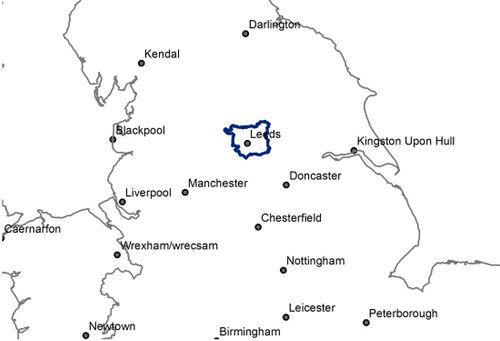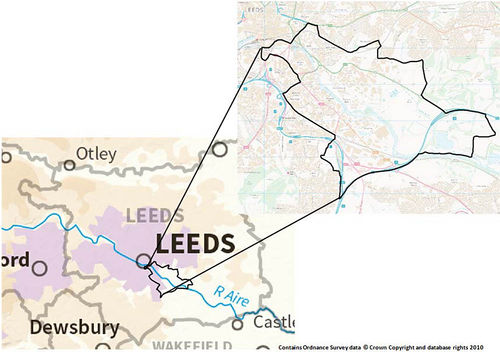OR/15/010 Study areas and data resources
| Terrington, R L, Thorpe, S, Burke, H, Smith, H, Price, S J. 2015. Enhance Mapping of Artificially Modified Ground in Urban Areas; Using borehole, Map and Remotely Sensed Data. British Geological Survey Internal Report, OR/15/010. |
Study area–Leeds
The Leeds borough unitary area was selected to study the borehole mapping of AMG. The area is approximately 552 km2 and is situated in West Yorkshire (Figure 1). Leeds was chosen as the project area as it has an estimated population of 757 700 people, making it the third largest city in the UK according to the Office for National Statistics (2012), and has a long history dating back to the 7th Century. Leeds initially developed as a market town and then played a pivotal role in the Industrial Revolution, centred on the production of wool, iron foundries, printing, flax and engineering. Following the decay of the post-industrial era, Leeds has become a banking, legal and retail centre, with much redevelopment occurring over the last 50 to 100 years in transport and infrastructure (Various, 2014[1]). Much of this redevelopment has occurred on Brownfield sites, where at its peak up to 97% of new residential properties in Leeds were built on this type of land in line with UK legislation (Brannen, 2012[2]) as opposed to being built on greenbelt. Leeds has many open cast coal mine operations, some of which have now been abandoned and reclaimed, particularly along the Aire Valley. In these areas artificial deposits can be variable in thickness and composition due to the variety of fill used (Waters et al., 1996[3]) and if not properly engineered or restored can pose a geohazard, such as subsidence at the margins of excavations (Price et al., 2011[4]). These factors make Leeds a logical choice as a case study for AMG.

The project area has been split into two for the purposes of this study. The overall Leeds borough unitary area was used as the project area to assess the start heights of boreholes for AMG, which can be automatically obtained from existing BGS databases. A smaller area, covering 13.35 km2 in the south west of the city along the Aire River valley was used to assess the presence/absence and thickness of anthropogenic deposits for mapping AMG (Figure 2) as these were coded manually into the BGS databases. The Aire Valley project area was incorporated within a larger zone of development in Leeds known as an Enterprise zone. This area will be the site for major development and redevelopment of industrial space, homes, and transport infrastructure from 2012 to 2015, with particular emphasis for ecologically sustainable options. This is part of a wider Government initiative rolled out to 21 other areas of the UK (http://airevalleyleeds.com/ez/). In the south east of this enterprise zone there is a site of a former opencast mine, which has been redeveloped into a country park, resulting in a mixture of residential, industrial, open parkland and former mining areas all of which need to be taken into consideration when analysing the borehole data against geomorphological landscape features.

Data sources
The following datasets were used in this study:
- NEXTMap® Britain Bald Earth Digital Terrain Model (DTM at 5 m resolution)
- LiDAR (DTM at 1 m resolution)
- Boreholes – data sourced from Single Onshore Borehole Index (SOBI) and Borehole Geology (BoGe) BGS databases
- Ordnance Survey topographic 1:10 000 and 1:50 000 scale maps
- Ordnance Survey Open data (Vector Map District and 1:250 000 colour raster data)
- DigMapGB 1:10 000 artificial layer (v2.18, released 15/01/2009)
- OS MasterMap® (for reference only)
- Aerial Photography (25 cm resolution)
The BGS Enhanced classification for Artificially Modified Ground, revised 2014 (Smith et al., 2014[5]), was adopted in this study where possible. The classification scheme attempts to subdivide AMG (Superclass) into Class, Type and Unit by using information based on the origin and landform of the deposit and excavation. This arrangement allows multiple divisions at a lower level in the hierarchy to be assigned to a single division at a higher level. These levels are analogous to the lithostratigraphical hierarchy of: Supergroup, Group, Formation and Member used to characterise bedrock and Quaternary geological units on BGS maps. Selected examples of this subdivision in the classification of AMG are shown in Figure 3. This classification does not consider actual Lithology of the material, but does indicate a landform type expression.

Software used
- ArcGIS v10.1
- MS Excel, Word and Access
- GeoVisionary (GV) v2.3
- GSI3D v2013
References
- ↑ VARIOUS, W-. 2014. http://en.wikipedia.org/wiki/Leeds. Wikipedia. [cited 2014]. http://en.wikipedia.org/wiki/Leeds
- ↑ BRANNEN, M A E. 2012. Report to the Scrutiny Board (Housing and Regeneration): Bringing Forward Brownfield Development Sites. Leeds City Council.
- ↑ WATERS, C N, NORTHMORE, K N, PRINCE, G, and MARKER, B R. 1996. A geological background for planning and development in the City of Bradford Metropolitan district. British Geological Survey, WA/96/1.
- ↑ PRICE, S J, BURKE, H F, TERRINGTON, R L, REEVES, H J, BOON, D, and SCHEIB, A J. 2011. The 3D characterisation of the zone of human interaction and the sustainable use of underground space in urban and peri-urban environments: case studies from the UK. Zeitschrift der Deutschen Gesellschaft fur Geowissenschaften, Vol. 161 (2), 219–235.
- ↑ SMITH, A, ALDISS, D T, FORD, J, PRICE, S J, and COOPER, A H. 2014. An enhanced classification for Artificially Modified Ground, revised 2014. British Gelogical Survey, OR/14/002 (British Geological Survey).